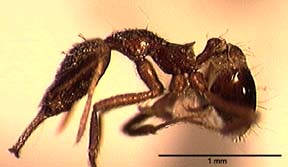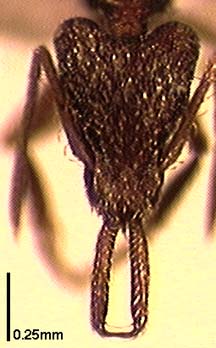Strumigenys micretes Brown 1959
Dacetini, Myrmicinae, Formicidae, Hymenoptera, Insecta, Arthropoda, Animalia
John T. Longino, The Evergreen State College, Olympia WA 98505
USA. longinoj@evergreen.edu
21 August 1997

Specimen: Costa Rica, Prov. Alajuela: Rio Penas Blancas, 800m (J. Longino 2529-s). INBIOCRI001281410. Image by J. Longino.
line drawings of lateral view and face view of lacacoca (from Brown 1962), a species nearly identical to micretes
|

Specimen: Costa Rica, Prov. Alajuela: Rio Penas Blancas, 800m (J. Longino 2529-s). INBIOCRI001281410. Image by J. Longino. |
Identification
Apical fork of mandible with one intercalary tooth; mandible often with acute preapical tooth very close to apical fork, but may be reduced to small denticle or absent; no other preapical teeth; gaster smooth and shining, with long flagelliform setae; pronotal dorsum finely reticulate-punctate, usually without any costulate sculpture; but if a few faint costulae occur they are
insignificant and obviously secondary to the reticulate-punctate component.
Head length 0.70-0.76mm, mandible length 0.45-0.51, CI 71-74, MI 62-68 (n=18 workers from 2 localities; Brown 1962).
Range
Costa Rica (Atlantic and southern Pacific lowlands and slopes to 800m).
Natural History
Brown and Wilson (1959) summarize the genus as follows:
"Widespread in tropics and warm temperate areas. Primarily forest-dwelling; some species occur in grassland and arid scrub. ... Nests mostly in soil and rotting wood; a few species live in arboreal plant cavities in tropical rain forest. Foraging hypogaeic to epigaeic-arboreal. Food: most species are collembolan feeders; a few are polyphagous predators or occasionally feed on sugary substances..."
micretes occurs in wet forest habitats. It nests in dead wood on the ground.
Selected Records
Winkler and/or Berlese samples from La Selva, Hitoy Cerere, Penas Blancas Valley, Carara, Manuel Antonio, Osa (Rancho Quemado).
La Selva: a nest was observed in dead wood on the ground. A dead branch was projecting from the leaf litter. The distal, projecting portion of the branch contained the Strumigenys colony. Just basal to the Strumigenys nest was an active Pachycondyla apicalis nest in the same branch.
La Selva: nest in Lecythis pod on ground.
Literature Cited
Brown, W. L., Jr. 1959. The Neotropical species of the ant genus Strumigenys Fr. Smith: Group of emeryi Mann. Entomological News 70:97-104.
Brown, W. L., Jr. 1962. The neotropical species of the ant genus Strumigenys Fr. Smith: Synopsis and keys to the species. Psyche 69:238-267.
Brown, W. L., Jr., Wilson, E. O. 1959. The evolution of the dacetine ants. Quarterly Review of Biology 34:278-294.
Previous versions of this page: 22 April 1997, 26 July 1997.
 Go back to top
Go back to top

